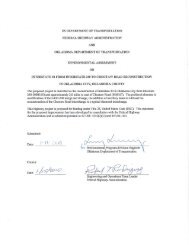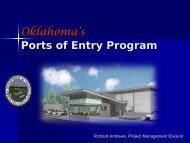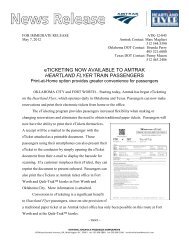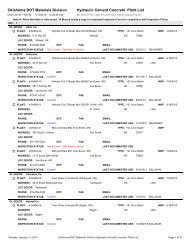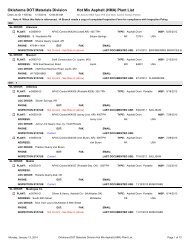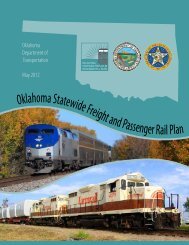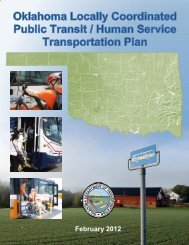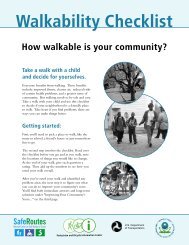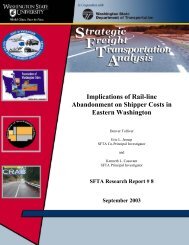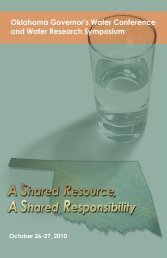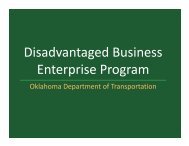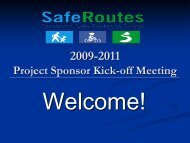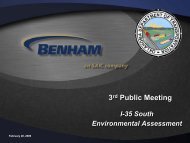Benefit Cost Analysis Technical Memo - Oklahoma Department of ...
Benefit Cost Analysis Technical Memo - Oklahoma Department of ...
Benefit Cost Analysis Technical Memo - Oklahoma Department of ...
You also want an ePaper? Increase the reach of your titles
YUMPU automatically turns print PDFs into web optimized ePapers that Google loves.
Freight Rail Improvements – <strong>Oklahoma</strong> City to Shawnee<br />
TIGER Grant Application<br />
<strong>Benefit</strong> <strong>Cost</strong> <strong>Analysis</strong> <strong>Technical</strong> <strong>Memo</strong><br />
October 2009<br />
Introduction<br />
The formal benefit cost analysis has been conducted using best practices for benefit cost<br />
analysis in transportation planning, and reflects all TIGER grant application guidelines. It is<br />
important to note that a formal benefit cost analysis is not a comprehensive measure <strong>of</strong> a<br />
project’s total economic impact, as many benefits cannot be readily quantified and occur under<br />
conditions <strong>of</strong> uncertainty. The broader set <strong>of</strong> long term economic benefits and impacts on local<br />
and regional economic well being and competitiveness are described in the TIGER grant<br />
application.<br />
However, to the maximum extent possible given available data, the formal benefit cost analysis<br />
prepared in connection with this TIGER grant application, and reported below, reflects<br />
quantifiable economic benefits in all five major long term impact areas identified in the TIGER<br />
grant application guidelines. These include:<br />
• State <strong>of</strong> Good Repair – accomplishment <strong>of</strong> the urgently-needed improvements to the<br />
track, track-bed, and eroded river banks will allow substantial reductions in train hours,<br />
operating costs, and maintenance <strong>of</strong> track and right <strong>of</strong> way. Life-cycle costs will be<br />
reduced; these will include reduced delays, slow orders, derailments, and temporary<br />
closures for emergency repairs and during summer temperature conditions.<br />
• Long Term Economic Competitiveness – reducing rail freight rail delays and the higher<br />
costs associated with diversion <strong>of</strong> freight from rail to trucks will allow industries and<br />
agricultural enterprises to reduce transportation costs, improve their logistics practices,<br />
and expand markets for both domestic and international shipments. This will help retain<br />
and create permanent jobs and improve the competitive position <strong>of</strong> domestic<br />
manufacturers and agricultural enterprises.<br />
• Sustainability – reducing emissions by making rail more efficient and avoiding diversion<br />
<strong>of</strong> freight from rail to truck will enhance sustainability in the region, and reduce<br />
Greenhouse Gas Emissions.<br />
• Livability – the corridor generally and the city <strong>of</strong> Shawnee in particular will benefit greatly<br />
from less delay-prone freight rail operation, and from the avoidance <strong>of</strong> noise, accident,<br />
and health effects <strong>of</strong> truck traffic that would result from rail closure.<br />
• Safety – avoiding increased truck traffic in the <strong>Oklahoma</strong> City – Shawnee corridor, which<br />
will result from freight rail discontinuation that will result if the project is not carried out,<br />
will yield measurable safety benefits in terms <strong>of</strong> reduced fatalities and other accidents.<br />
Given the caveats above, the computed benefit-cost ratio for the Shawnee freight rail project,<br />
described in detail in the <strong>Benefit</strong>-<strong>Cost</strong> Results section <strong>of</strong> this report, is 4.5, calculated using a<br />
discount rate <strong>of</strong> seven percent, and 6.4 at a discount rate <strong>of</strong> three percent.<br />
1
A Note on the Discount Rates<br />
As required by the Federal Register guidelines for TIGER grant applications, a seven percent<br />
discount rate has been applied uniformly to all project costs and benefits to arrive at the<br />
discounted benefit cost ratio and net present value. As an alternative, and again in keeping with<br />
the Federal Register guidelines, benefits and costs have also been valued using a three percent<br />
discount rate. Sources for these rates are OMB circulars A-4 and A-94, where seven percent is<br />
represented as the average expected return on private capital and three percent represents the<br />
social rate <strong>of</strong> time preference. The higher rate is intended to provide a private sector investment<br />
benchmark for assessing government projects, while the lower rate is an estimate <strong>of</strong> the social<br />
rate <strong>of</strong> time preference for households and individuals. The former might be more appropriately<br />
applied to benefit streams that accrue to private firms, while the latter might be more<br />
appropriately applied to long term benefits that accrue strictly to current households and<br />
subsequent generations, and even more particularly where these benefits accrue to lower<br />
income households for whom long term wealth accumulation or future social benefits will be<br />
more highly valued.<br />
No specific attempt has been made in the benefit cost analysis presented in this application to<br />
apply different discount rates to different benefit or cost streams. However, as projects will<br />
typically benefit a mixture <strong>of</strong> private and public stakeholders, as well as different income or<br />
social groups, the B/C ratios would undoubtedly fall somewhere between those computed at<br />
seven percent and three percent had this been done.<br />
The Project and the Alternative (No Build)<br />
The project consists <strong>of</strong> rehabilitation <strong>of</strong> the track, active warning devices and subgrade <strong>of</strong> the<br />
A-OK Shawnee line to support operating speeds up to 25 miles per hour. Also included are<br />
track and crossing improvements on a BNSF track extending to the north <strong>of</strong> Shawnee from the<br />
eastern end <strong>of</strong> the A-OK Shawnee line.<br />
The track between <strong>Oklahoma</strong> City and Shawnee has deteriorated to Exempted Class, which by<br />
regulation may only operate at a maximum speed <strong>of</strong> 10 MPH. Poor track conditions lead to<br />
higher operating costs and slimmer margins <strong>of</strong> net revenue available to correct the situation. A<br />
flood event could easily undermine the trackbed at more than one location and render<br />
reconstruction beyond the financial means <strong>of</strong> the line. In this case, the line would be<br />
embargoed and rail service to A-OK and BNSF customers in Shawnee and between <strong>Oklahoma</strong><br />
City and Shawnee would cease.<br />
Consequently it is concluded in this analysis <strong>of</strong> benefits and costs that withdrawal <strong>of</strong> freight rail<br />
service is imminent. In the “No Build” scenario (absence <strong>of</strong> the project), freight service in the<br />
corridor served by the current rail operations is assumed to cease within two years, to be<br />
replaced by truck freight service during the remaining 20 years <strong>of</strong> the analysis period. The<br />
products shipped by the A-OK and BNSF customers are commodities requiring single-mode<br />
origin-to-destination service. As a result, the change from rail to truck would apply to the entire<br />
origin-to-destination length <strong>of</strong> the shipments. Based on information provided by specific<br />
Shawnee-area customers, the national average trip length for car-load freight is adopted as<br />
applicable to this analysis.<br />
2
Cessation <strong>of</strong> service is assumed not to affect the automotive train service provided by A-OK.<br />
This service occurs within the western portion <strong>of</strong> the A-OK and would not be affected by a flood<br />
event closing the line. This service can be maintained with or without the rehabilitation project<br />
<strong>Benefit</strong>s <strong>of</strong> the Project<br />
The primary direct benefits <strong>of</strong> the project result from avoidance <strong>of</strong> the loss <strong>of</strong> freight rail service<br />
currently provided by the A-OK in the <strong>Oklahoma</strong> City – Shawnee corridor, including the access it<br />
provides to the nine-mile BNSF line extending northward from Shawnee. BNSF access to their<br />
line is dependent on trackage rights over the A-OK from <strong>Oklahoma</strong> City. In the absence <strong>of</strong><br />
freight rail service, customers in and near Shawnee would be forced to discontinue or relocate<br />
their businesses, or rely instead on freight movement by truck. This transfer from rail to truck<br />
would have a number <strong>of</strong> quantifiable economic costs, affecting freight customers and the area<br />
population at large. Based upon currently available data, the initial magnitude <strong>of</strong> this transfer <strong>of</strong><br />
freight movement from rail to truck would be as described in Table 1. The A-OK has identified<br />
market growth over the next five years for specific customers, raising total annual freight cars<br />
per year from the current level, 1,927 to 2,892 (both excluding the automotive business close to<br />
<strong>Oklahoma</strong> City). In the table, allowance is made for delay in realizing that growth, because <strong>of</strong><br />
the current track condition and the period <strong>of</strong> construction; the identified growth is shown to have<br />
occurred by the year 2015, six years from the present and three years after completion <strong>of</strong><br />
construction.<br />
Table 1: Rail Freight Movement, <strong>Oklahoma</strong> City – Shawnee Area<br />
Annual Data 2012 2015 2029<br />
Freight Cars per Year 1,927 2,892 3,816<br />
Typical Freight Tons per Car 90 90 90<br />
Freight Tons Carried per Year 173,430 260,280 343,434<br />
Typical Miles Hauled 538 538 538<br />
Freight Ton Miles per Year 93,305,340 140,030,640 184,767,456<br />
Typical Freight Tons per Truck 21 21 21<br />
Truck Trips Required if No Rail 8,259 12,394 16,354<br />
Truck Miles (VMT) if No Rail 4,443,111 6,668,126 8,798,450<br />
Source: Compiled from A-OK and BNSF Customer Data and AASHTO statistics<br />
Note: Rail freight data unless otherwise specified.<br />
Although the project is compared with replacement <strong>of</strong> rail freight service with truck freight in the<br />
analysis <strong>of</strong> benefits and costs, the project will in fact bring immediate benefits to rail freight<br />
operations and customers. Railroad operating costs will benefit from reduced train hours as a<br />
result <strong>of</strong> higher operating speeds. Rail freight customers will benefit from improved predictability<br />
<strong>of</strong> rail car deliveries, which at present are subject to significant delays as a result <strong>of</strong> excessive<br />
train travel times, which sometimes prevent completion <strong>of</strong> operations as scheduled. This is a<br />
problem especially during summer months, when high temperatures cause track deformation<br />
with consequent slow orders and line closing.<br />
3
Economic benefits <strong>of</strong> the project have been estimated at year 2009 price levels. The benefits<br />
include:<br />
(1) Fuel savings, quantified<br />
Failure to implement the project is assumed to result in withdrawal <strong>of</strong> rail service after two<br />
years, as noted in the introduction to this Section. The No Build scenario would result in all<br />
freight otherwise shipped by rail having to be shipped by truck. The consequent increase in<br />
trucking will result in greater use <strong>of</strong> motor fuels, because <strong>of</strong> the relative inefficiency <strong>of</strong><br />
diesel or gasoline-fueled trucks compared with diesel-electric rail locomotives.<br />
Assuming all trucks would be diesel-fueled, the excess fuel use if the current level <strong>of</strong> rail freight<br />
service were to be withdrawn would be 653 thousand gallons in 2012, growing to 1.293 million<br />
gallons in the year 2029. The value associated with these fuel cost savings has been<br />
accounted for in the corresponding shipping cost estimates, which are summarized for selected<br />
years in Table 4 later in this report.<br />
(2) Customer (Shipper) cost savings, quantified<br />
The project will result in small reductions in rail Operating & Maintenance (O&M) costs, which<br />
are not assumed to be passed on to customers. Because failure to implement the project will<br />
result in withdrawal <strong>of</strong> rail service within the project area after an assumed two years, the No<br />
Build alternative would result in freight otherwise shipped by rail having to be shipped by truck.<br />
Trucking is more expensive than shipping by rail; benefits accrue to customers as a result <strong>of</strong><br />
lower shipping costs via rail. The project, by preserving and improving rail freight service, would<br />
save customers an estimated value <strong>of</strong> $9.7 million in 2012, compared with the cost <strong>of</strong> shipping<br />
by truck. This amount is projected to grow to $14.5 million annually by 2015 and to $18.9 million<br />
annually by 2029.<br />
(3) Greenhouse gas emissions (reduced), quantified<br />
The increase in trucking in the No Build alternative will result in increased emissions <strong>of</strong><br />
greenhouse gases. Diesel or gasoline-fueled trucks are relatively inefficient compared with<br />
diesel-electric locomotives and the lower energy per ton-mile required when moving freight via<br />
rail. Greenhouse gas (measured by CO 2 ) reductions are projected to be 26.7 thousand tons in<br />
2012, rising to 52.8 thousand tons by 2029. The benefit at $7.00 per metric ton grows from $187<br />
thousand to $370 thousand per year, between 2012 and 2029.<br />
(4) Public health benefits<br />
As discussed, the No Build alternative would see all freight otherwise shipped by rail having to<br />
be shipped by truck. The consequent increase in trucking will have an adverse effect on air<br />
quality within the corridor, and may also result in localized noise increases. The economic<br />
benefit <strong>of</strong> air quality improvements (measured by HC, NOx, and PM10) <strong>of</strong> the project gradually<br />
declines from $174 thousand in 2012 to $12 thousand in 2029, as more stringent regulations<br />
result in cleaner diesel exhaust.<br />
(5) Other costs and benefits related to vehicle miles <strong>of</strong> travel<br />
The project will result in road traffic vehicle-miles-<strong>of</strong> travel (VMT) reductions as compared to the<br />
No Build alternative. There would be consequent savings in road maintenance and operating<br />
costs that would result from avoided road deterioration. Also, there would be improved traffic<br />
safety, producing reduced accident costs. Road maintenance expenditures anticipated to be<br />
eliminated by the project amount to $1.2 million in 2012 and $2.3 million by 2029. Accident<br />
costs are projected to be reduced by $2.9 million in 2012 and $5.8 million in 2029, assuming no<br />
changes in accident rates over this period.<br />
4
<strong>Cost</strong>s <strong>of</strong> the Project<br />
The project entails the design and construction <strong>of</strong> capital improvements including river bank<br />
stabilization, track reconstruction, and rail-highway grade crossing improvements. Track<br />
reconstruction and rail-highway grade crossing improvements are included for both the A-OK<br />
and BNSF portions <strong>of</strong> the project.<br />
Capital <strong>Cost</strong>s<br />
These costs include not only construction costs, but also design and project management costs.<br />
The estimated cost <strong>of</strong> the first phase <strong>of</strong> the project, including design and construction, is<br />
$32,105,949. Construction would be initiated in the second quarter <strong>of</strong> 2010 and would be<br />
completed in 2011, with approximately $20.8 million expended in 2010, and $11.3 million in<br />
2011. The drawdown <strong>of</strong> funds is tabulated in Table 2.<br />
5
Table 2: Capital <strong>Cost</strong> Drawdown Schedule<br />
Quarters, 2010 Quarters, 2011<br />
Capital <strong>Cost</strong><br />
Totals 1 2 3 4 1 2 3 4<br />
River Bank Restoration 50% 50%<br />
MP447.8 to MP483.0 $ 8,487,625<br />
$ 4,243,813 $ 4,243,813<br />
Crosstie Renewals 50% 50%<br />
$ 9,615,375<br />
$ 4,807,688 $ 4,807,688<br />
Rebuild 12 Grade Crossings 100%<br />
$ 446,850<br />
$ 446,850<br />
Rebuild Canadian River Approach Spans 100%<br />
BR 455.33 $ 538,250<br />
$ 538,250<br />
Repair 457.54 and 478.91 Bridges 100%<br />
$ 640,500<br />
$ 640,500<br />
QUARTERLY EXPENDITURES $ 9,051,500 $ 9,051,500 $ - $ - $ 1,625,600 $ - $ -<br />
Contingency 15% $ 1,357,725 $ 1,357,725 $ - $ - $ 243,840 $ - $ -<br />
QUARTERLY TOTALS $ 22,687,890<br />
$ 10,409,225 $ 10,409,225 $ - $ - $ 1,869,440 $ - $ -<br />
Additional Grade Crossings Improvements $ 5,452,000<br />
$ 5,452,000<br />
BNSF Improvements $ 3,966,059<br />
SHAWNEE PROJECT TOTAL $ 32,105,949<br />
2010<br />
$ 20,818,450<br />
2011<br />
$<br />
11,287,499<br />
6
<strong>Benefit</strong>-<strong>Cost</strong> Results<br />
The analysis <strong>of</strong> benefits and costs finds that the Net Present Value (NPV) <strong>of</strong> the project<br />
benefits is:<br />
$130.5 million at a seven percent discount rate<br />
$198.5 million at a three percent discount rate.<br />
These benefits compare with present values <strong>of</strong> the project cost, which are:<br />
$29.3 million at a seven percent discount rate<br />
$30.9 million at a three percent discount rates<br />
The resulting <strong>Benefit</strong>/<strong>Cost</strong> (B/C) ratio is:<br />
$130.5 M/$29.3M or 4.5 at the seven percent discount rate, and<br />
$198.5M/$30.9M or 6.4 at the three percent discount rate.<br />
In either case, benefits will exceed costs within six years.<br />
Table 3 provides the basic factors and unit costs used in the analysis, which compares<br />
the cost <strong>of</strong> freight shipment by truck, if the project is not built, with the cost <strong>of</strong> freight<br />
shipment by rail upon completion <strong>of</strong> reconstruction <strong>of</strong> the line.<br />
<strong>Cost</strong>/<strong>Benefit</strong> Summary<br />
Table 4 summarizes the costs and the quantifiable benefits <strong>of</strong> the project that are<br />
discussed above. The table shows estimates for years 2010, 2012, 2015, and 2029, and<br />
the project’s net present value and benefit/cost ratio, using both the three percent and the<br />
seven percent discount rates suggested in the TIGER guidance. Table 5 provides the<br />
entire 20-year forecast, for the years 2010-2029.<br />
Other Non-Quantifiable <strong>Benefit</strong>s<br />
The true measure <strong>of</strong> all <strong>of</strong> this project’s benefits is not summarized in the table, as many<br />
benefits cannot readily be quantified. The regional economic benefit in terms <strong>of</strong><br />
population and employment growth resulting from having a fully operational railroad link<br />
between <strong>Oklahoma</strong> City and Shawnee and vicinity will include support for growth <strong>of</strong><br />
existing rail freight customers’ businesses as well as attraction <strong>of</strong> additional companies to<br />
be started or to relocate to the area. The consequences to the community at large will be<br />
major and enduring.<br />
7
Table 3: Factors for Calculation <strong>of</strong> Economic <strong>Cost</strong>s<br />
Value Units or Rates<br />
Performance or <strong>Cost</strong> Item<br />
2010 2020 2020 values continue through 2029 Unit <strong>Cost</strong> Units<br />
Average tons per rail car 90 90 tons (typical value)<br />
Average tons per truck 21 21 tons (AASHTO)<br />
Average origin-destination length <strong>of</strong> haul 538 538 miles (AASHTO national avg. value, car-load freight, yr. 2000)<br />
Average shipper cost per ton-mile, rail $ 0.024 $ 0.024 AASHTO report<br />
Average shipper cost per ton-mile, truck $ 0.080 $ 0.080 AASHTO report<br />
Average ton miles per gallon diesel, rail 396 396 AASHTO report<br />
Average ton miles per gallon diesel, truck 105 105 assumption, PB<br />
Rail air pollutants, HC 9.20 8.00 grams per locomotive mile (linear change, 2010-2020) $ 0.0017 per gram<br />
Rail air pollutants, CO 27.40 27.40 grams per locomotive mile $ - per gram<br />
Rail air pollutants, NOx 163.70 140.80 grams per locomotive mile (linear change, 2010-2020) $ 0.0040 per gram<br />
Rail air pollutants, PM10 5.70 4.90 grams per locomotive mile (linear change, 2010-2020) $ 0.1680 per gram<br />
Ton miles per rail locomotive mile 3,600 3,600 assumption<br />
Rail CO2 emissions 0.024 0.024 kg per freight ton-mile $ 0.0070 per kg<br />
Truck air pollutants, VOC 0.28 0.20 grams per truck mile (linear change, 2010-2020) $ 0.0017 per gram<br />
Truck air pollutants, CO 1.14 0.25 grams per truck mile (linear change, 2010-2020) $ - per gram<br />
Truck air pollutants, NOx 8.38 1.28 grams per truck mile (linear change, 2010-2020) $ 0.0040 per gram<br />
Truck air pollutants, PM10 0.17 0.07 grams per truck mile (linear change, 2010-2020) $ 0.1680 per gram<br />
Truck CO2 emissions 0.310 0.310 kg per freight ton-mile $ 0.0070 per kg<br />
Rail accident costs per train mile $ 6.570 $ 6.570 derived from AAR and FRA data and TIGER guidelines<br />
Highway accident cost per truck mile $ 0.700 $ 0.700 derived from FHWA (USDOT) data and TIGER guidelines<br />
Highway maintenance cost per truck mile $ 0.265 $ 0.265<br />
Rail freight growth rate after year 2014 2% 2% growth rate - approx. nat'l avg. (AASHTO) for carload freight<br />
AASHTO source is "Transportation - Invest in America: Freight-Rail Bottom Line Report"<br />
8
Table 4: Summary Economic Forecast, Selected Years<br />
Present Values<br />
20-year evaluation, selected years only<br />
at 7% at 3% 2010 2012 2015 2029<br />
RAIL, Build Scenario<br />
$ 34,546,759 $ 50,699,988 Shipper cost, estimated total $ 2,239,328 $ 2,239,328 $ 3,360,735 $ 4,434,419<br />
$ 241,827 $ 354,900 Greenhouse gas emissions (CO2) $ 15,675 $ 15,675 $ 23,525 $ 31,041<br />
$ 589,205 $ 855,978 Public health (air quality measures) $ 42,196 $ 41,014 $ 58,891 $ 71,854<br />
$ 2,626,993 $ 3,855,312 Accidents $ 170,282 $ 170,282 $ 255,556 $ 337,201<br />
$ - $ - Highway maintenance cost (null case) $ - $ - $ - $<br />
-<br />
$ 38,004,784 $ 55,766,177 Total Economic <strong>Cost</strong>, Rail $ 2,467,481 $ 2,466,299 $ 3,698,708 $ 4,874,514<br />
TRUCK (Rail in 2010 & 2011), No Build Scenario<br />
$ 105,708,790 $ 159,001,891 Shipper cost, estimated total $ 2,239,328 $ 7,464,427 $ 11,202,451 $ 14,781,396<br />
$ 2,785,870 $ 4,226,693 Greenhouse gas emissions (CO2) $ 15,675 $ 202,473 $ 303,866 $ 400,945<br />
$ 1,353,801 $ 1,820,762 Public health (air quality measures) $ 42,196 $ 1,994 $ 2,721 $ 2,991<br />
$ 42,666,225 $ 64,791,248 Accidents $ 170,282 $ - $ - $<br />
-<br />
$ 16,035,662 $ 24,404,766 Highway maintenance cost (null case) $ - $ 207,810 $ 216,431 $ 75,681<br />
$ 168,550,347 $ 254,245,359 Total Economic <strong>Cost</strong>, Truck $ 2,467,481 $ 12,169,429 $ 18,166,413 $ 23,756,436<br />
COST SAVINGS (Economic <strong>Benefit</strong>, No Build minus Build)<br />
$ 71,162,030 $ 108,301,903 Shipper cost, estimated total $ - $ 5,225,099 $ 7,841,716 $ 10,346,978<br />
$ 2,544,043 $ 3,871,793 Greenhouse gas emissions (CO2) $ - $ 186,797 $ 280,341 $ 369,904<br />
$ 764,597 $ 964,784 Public health (air quality measures) $ - $ (39,020) $ (56,171) $ (68,863)<br />
$ 40,039,232 $ 60,935,937 Accidents $ - $ (170,282) $ (255,556) $ (337,201)<br />
$ 16,035,662 $ 24,404,766 Highway maintenance cost (null case) $ - $ 207,810 $ 216,431 $ 75,681<br />
$ 130,545,563 $ 198,479,182 <strong>Benefit</strong> <strong>of</strong> the Project (Truck minus Rail) $ - $ 9,703,129 $ 14,467,706 $ 18,881,921<br />
$ 29,315,434 $ 30,851,638 PROJECT COST (2011 not shown) $ 20,818,450<br />
4.45 6.43 B/C Ratio<br />
$ 101,230,129 $ 167,627,544 Net Present Value <strong>of</strong> Project<br />
6 6 Years to Break-Even<br />
9
Table 5: Annual Economic <strong>Cost</strong>s, Present Values, Project Net Present Values, and <strong>Benefit</strong>/<strong>Cost</strong> Ratios<br />
Present Values<br />
at 7% at 3%<br />
20-year evaluation<br />
2010 2011 2012 2013 2014 2015 2016 2017 2018 2019 2020 2021 2022 2023 2024 2025 2026 2027 2028 2029<br />
RAIL<br />
Annual rail cars hauled 1,927 1,927 1,927 2,249 2,571 2,892 2,950 3,009 3,069 3,130 3,193 3,257 3,322 3,388 3,456 3,525 3,596 3,668 3,741 3,816<br />
Annual commodity tons carried 173,430 173,430 173,430 202,410 231,390 260,280 265,486 270,795 276,211 281,735 287,370 293,118 298,980 304,960 311,059 317,280 323,625 330,098 336,700 343,434<br />
Annual ton-miles carried 93,305,340 93,305,340 93,305,340 108,896,580 124,487,820 140,030,640 142,831,253 145,687,878 148,601,635 151,573,668 154,605,141 157,697,244 160,851,189 164,068,213 167,349,577 170,696,569 174,110,500 177,592,710 181,144,564 184,767,456<br />
Fuel consumed 235,620 235,620 235,620 274,991 314,363 353,613 360,685 367,899 375,257 382,762 390,417 398,225 406,190 414,314 422,600 431,052 439,673 448,466 457,436 466,584<br />
Locomotive miles 25,918 25,918 25,918 30,249 34,580 38,897 39,675 40,469 41,278 42,104 42,946 43,805 44,681 45,575 46,486 47,416 48,364 49,331 50,318 51,324<br />
$ 34,546,759 $ 50,699,988 Shipper cost $ 2,239,328 $ 2,239,328 $ 2,239,328 $ 2,613,518 $ 2,987,708 $ 3,360,735 $ 3,427,950 $ 3,496,509 $ 3,566,439 $ 3,637,768 $ 3,710,523 $ 3,784,734 $ 3,860,429 $ 3,937,637 $ 4,016,390 $ 4,096,718 $ 4,178,652 $ 4,262,225 $ 4,347,470 $ 4,434,419<br />
$ 241,827 $ 354,900 <strong>Cost</strong>, CO2 $ 15,675 $ 15,675 $ 15,675 $ 18,295 $ 20,914 $ 23,525 $ 23,996 $ 24,476 $ 24,965 $ 25,464 $ 25,974 $ 26,493 $ 27,023 $ 27,563 $ 28,115 $ 28,677 $ 29,251 $ 29,836 $ 30,432 $ 31,041<br />
$ 5,701 $ 8,289 <strong>Cost</strong>, HC $ 405 $ 400 $ 395 $ 455 $ 513 $ 569 $ 572 $ 575 $ 578 $ 581 $ 584 $ 596 $ 608 $ 620 $ 632 $ 645 $ 658 $ 671 $ 684 $ 698<br />
$ - $ - <strong>Cost</strong>, CO $ - $ - $ - $ - $ - $ - $ - $ - $ - $ - $ - $ - $ - $ - $ - $ - $ - $ - $ - $<br />
-<br />
$ 237,011 $ 344,327 <strong>Cost</strong>, NOx $ 16,971 $ 16,734 $ 16,496 $ 18,976 $ 21,376 $ 23,689 $ 23,799 $ 23,904 $ 24,004 $ 24,099 $ 24,187 $ 24,671 $ 25,164 $ 25,668 $ 26,181 $ 26,705 $ 27,239 $ 27,783 $ 28,339 $ 28,906<br />
$ 346,493 $ 503,362 <strong>Cost</strong> PM10 $ 24,819 $ 24,471 $ 24,123 $ 27,747 $ 31,255 $ 34,634 $ 34,794 $ 34,946 $ 35,090 $ 35,226 $ 35,353 $ 36,060 $ 36,781 $ 37,517 $ 38,267 $ 39,033 $ 39,813 $ 40,610 $ 41,422 $ 42,250<br />
$ 2,626,993 $ 3,855,312 <strong>Cost</strong>, accidents $ 170,282 $ 170,282 $ 170,282 $ 198,736 $ 227,190 $ 255,556 $ 260,667 $ 265,880 $ 271,198 $ 276,622 $ 282,154 $ 287,797 $ 293,553 $ 299,424 $ 305,413 $ 311,521 $ 317,752 $ 324,107 $ 330,589 $ 337,201<br />
$ 38,004,784 $ 55,766,177 Total Economic <strong>Cost</strong>, Rail $ 2,467,481 $ 2,466,890 $ 2,466,299 $ 2,877,726 $ 3,288,955 $ 3,698,708 $ 3,771,777 $ 3,846,290 $ 3,922,274 $ 3,999,760 $ 4,078,776 $ 4,160,351 $ 4,243,558 $ 4,328,429 $ 4,414,998 $ 4,503,298 $ 4,593,364 $ 4,685,231 $ 4,778,936 $ 4,874,514<br />
TRUCK (RAIL IN 2010 AND 2011)<br />
Annual commodity tons carried 173,430 173,430 173,430 202,410 231,390 260,280 265,486 270,795 276,211 281,735 287,370 293,118 298,980 304,960 311,059 317,280 323,625 330,098 336,700 343,434<br />
Annual ton-miles carried 93,305,340 93,305,340 93,305,340 108,896,580 124,487,820 140,030,640 142,831,253 145,687,878 148,601,635 151,573,668 154,605,141 157,697,244 160,851,189 164,068,213 167,349,577 170,696,569 174,110,500 177,592,710 181,144,564 184,767,456<br />
Annual truck trips 8,259 9,639 11,019 12,394 12,642 12,895 13,153 13,416 13,684 13,958 14,237 14,522 14,812 15,109 15,411 15,719 16,033 16,354<br />
Annual truck vehicle miles 4,443,111 5,185,551 5,927,991 6,668,126 6,801,488 6,937,518 7,076,268 7,217,794 7,362,150 7,509,393 7,659,580 7,812,772 7,969,027 8,128,408 8,290,976 8,456,796 8,625,932 8,798,450<br />
Fuel consumed 235,620 235,620 888,622 1,037,110 1,185,598 1,333,625 1,360,298 1,387,504 1,415,254 1,443,559 1,472,430 1,501,879 1,531,916 1,562,554 1,593,805 1,625,682 1,658,195 1,691,359 1,725,186 1,759,690<br />
$ 105,708,790 $ 159,001,891 Shipper cost $ 2,239,328 $ 2,239,328 $ 7,464,427 $ 8,711,726 $ 9,959,026 $ 11,202,451 $ 11,426,500 $ 11,655,030 $ 11,888,131 $ 12,125,893 $ 12,368,411 $ 12,615,780 $ 12,868,095 $ 13,125,457 $ 13,387,966 $ 13,655,726 $ 13,928,840 $ 14,207,417 $ 14,491,565 $ 14,781,396<br />
$ 2,785,870 $ 4,226,693 <strong>Cost</strong>, CO2 $ 15,675 $ 15,675 $ 202,473 $ 236,306 $ 270,139 $ 303,866 $ 309,944 $ 316,143 $ 322,466 $ 328,915 $ 335,493 $ 342,203 $ 349,047 $ 356,028 $ 363,149 $ 370,412 $ 377,820 $ 385,376 $ 393,084 $ 400,945<br />
$ 23,270 $ 34,505 <strong>Cost</strong>, VOC $ 405 $ 400 $ 1,994 $ 2,257 $ 2,499 $ 2,721 $ 2,683 $ 2,642 $ 2,598 $ 2,552 $ 2,503 $ 2,553 $ 2,604 $ 2,656 $ 2,709 $ 2,764 $ 2,819 $ 2,875 $ 2,933 $ 2,991<br />
$ - $ - <strong>Cost</strong>, CO $ - $ - $ - $ - $ - $ - $ - $ - $ - $ - $ - $ - $ - $ - $ - $ - $ - $ - $ - $<br />
-<br />
$ 1,241,397 $ 1,674,396 <strong>Cost</strong>, NOx $ 16,971 $ 16,734 $ 207,810 $ 217,793 $ 220,692 $ 216,431 $ 188,309 $ 158,975 $ 128,392 $ 96,522 $ 63,326 $ 64,593 $ 65,885 $ 67,202 $ 68,546 $ 69,917 $ 71,316 $ 72,742 $ 74,197 $ 75,681<br />
$ 89,134 $ 111,860 <strong>Cost</strong> PM10 $ 24,819 $ 24,471 $ 5,123 $ 5,594 $ 5,954 $ 6,203 $ 5,821 $ 5,423 $ 5,006 $ 4,570 $ 4,114 $ 4,197 $ 4,281 $ 4,366 $ 4,454 $ 4,543 $ 4,634 $ 4,726 $ 4,821 $ 4,917<br />
$ 42,666,225 $ 64,791,248 <strong>Cost</strong>, accidents $ 170,282 $ 170,282 $ 3,110,178 $ 3,629,886 $ 4,149,594 $ 4,667,688 $ 4,761,042 $ 4,856,263 $ 4,953,388 $ 5,052,456 $ 5,153,505 $ 5,256,575 $ 5,361,706 $ 5,468,940 $ 5,578,319 $ 5,689,886 $ 5,803,683 $ 5,919,757 $ 6,038,152 $ 6,158,915<br />
$ 16,035,662 $ 24,404,766 Highway maintenance cost $ - $ - $ 1,177,425 $ 1,374,171 $ 1,570,918 $ 1,767,053 $ 1,802,394 $ 1,838,442 $ 1,875,211 $ 1,912,715 $ 1,950,970 $ 1,989,989 $ 2,029,789 $ 2,070,385 $ 2,111,792 $ 2,154,028 $ 2,197,109 $ 2,241,051 $ 2,285,872 $ 2,331,589<br />
$ 168,550,347 $ 254,245,359 Total Economic <strong>Cost</strong>, Truck $ 2,467,481 $ 2,466,890 $ 12,169,429 $ 14,177,733 $ 16,178,821 $ 18,166,413 $ 18,496,693 $ 18,832,917 $ 19,175,191 $ 19,523,623 $ 19,878,323 $ 20,275,889 $ 20,681,407 $ 21,095,035 $ 21,516,936 $ 21,947,275 $ 22,386,220 $ 22,833,944 $ 23,290,623 $ 23,756,436<br />
$ 130,545,563 $ 198,479,182 <strong>Benefit</strong> <strong>of</strong> the Project (Truck minus Rail) $ - $ - $ 9,703,129 $ 11,300,007 $ 12,889,866 $ 14,467,706 $ 14,724,916 $ 14,986,627 $ 15,252,917 $ 15,523,864 $ 15,799,547 $ 16,115,538 $ 16,437,849 $ 16,766,606 $ 17,101,938 $ 17,443,977 $ 17,792,856 $ 18,148,713 $ 18,511,688 $ 18,881,921<br />
$ 29,315,434 $ 30,851,638 PROJECT COST $ 20,818,450 $ 11,287,499<br />
this assumes same on-going O&M cost as at present -- fewer problems but higher level <strong>of</strong> track maintenance<br />
4.45 6.43 B/C Ratio<br />
$ 101,230,129 $ 167,627,544 Net Present Value <strong>of</strong> Project<br />
6 6 Years to Break-Even<br />
10




